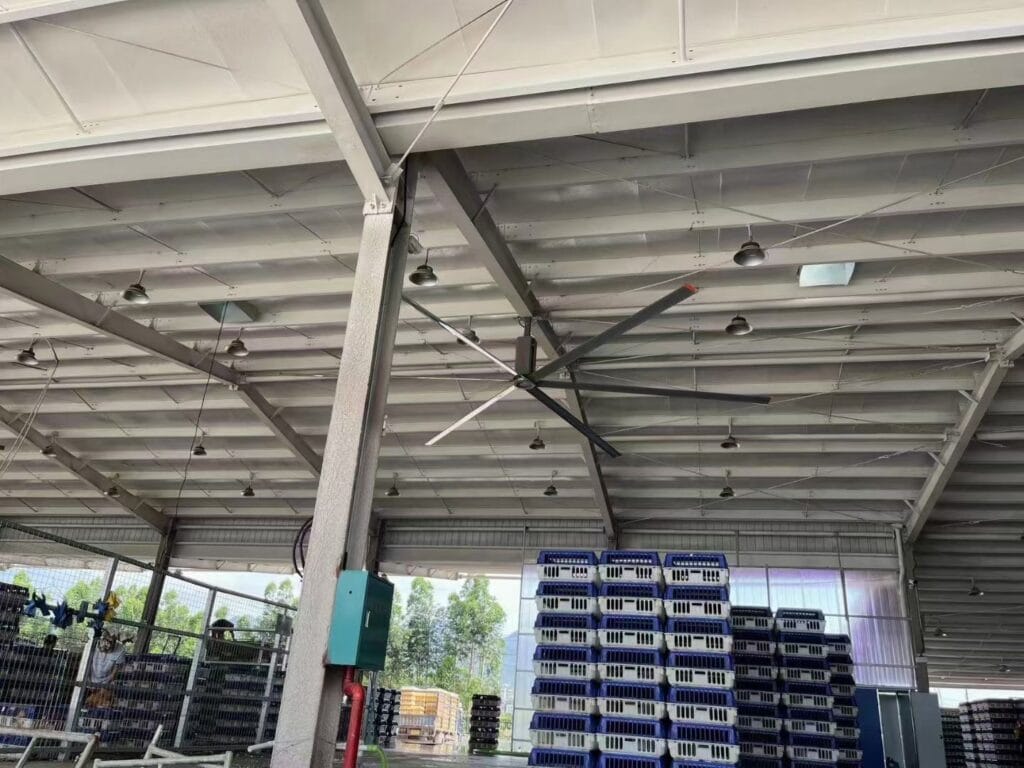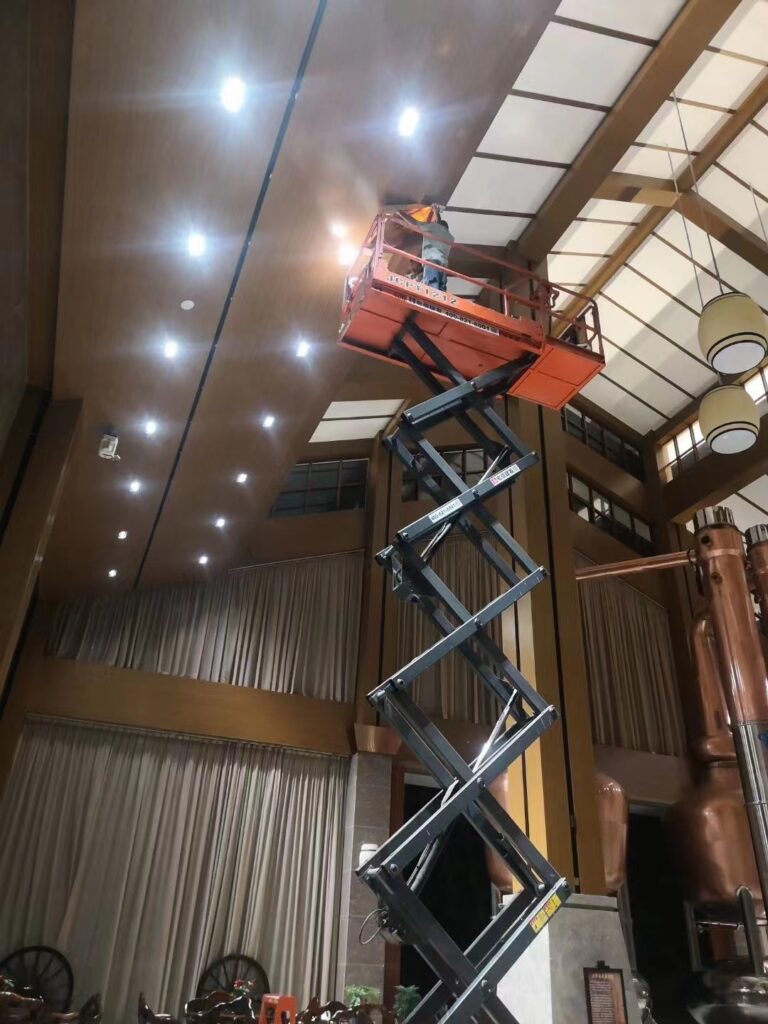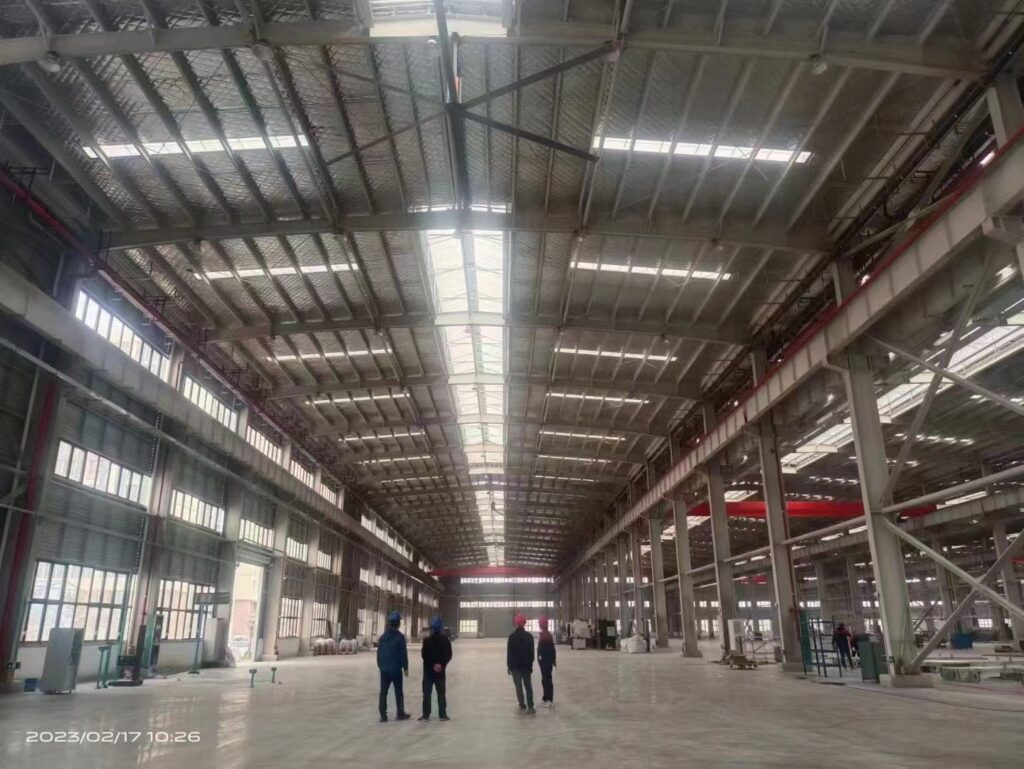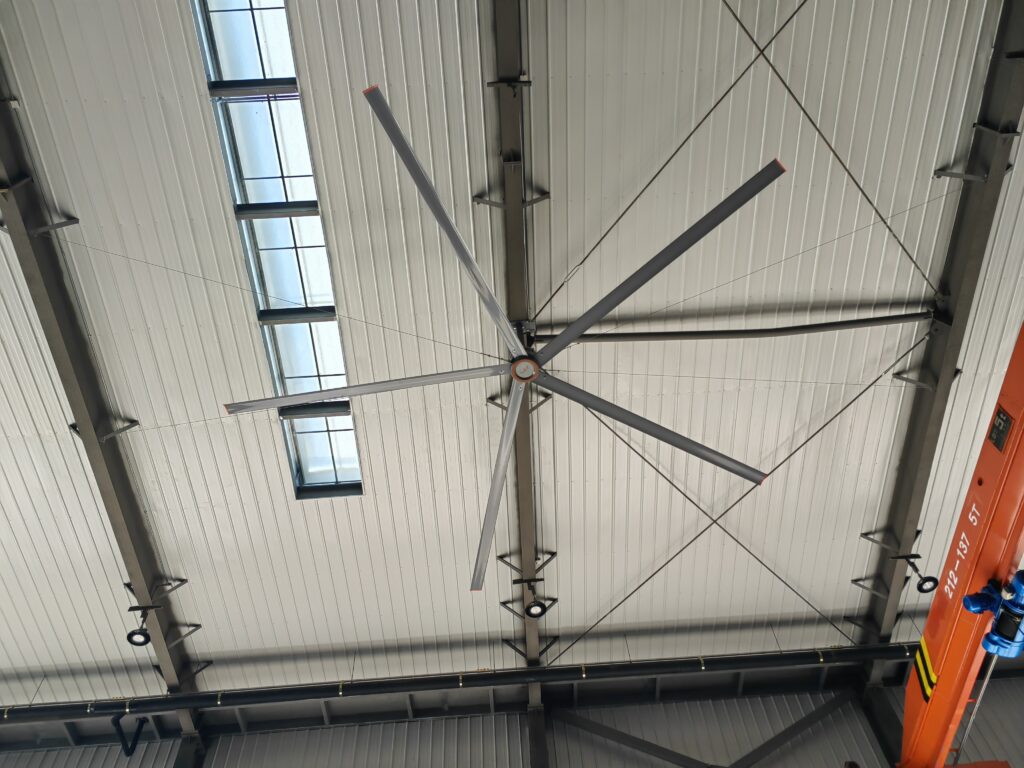Workshops are busy places where focus, safety, and precision are paramount, but noise is constant due to the noise generated by machinery and tools. This can be added with loud cooling systems, which make communication difficult and stressful for the workers. To workshop owners, facility managers, and safety supervisors, it is of paramount importance to ensure that the room is comfortable and productive without noise.
The most effective cooling method in the workshop would be industrial ceiling fans, especially the High-Volume Low-Speed (HVLS) types, due to their robust airflow and low operating noise (that would not add unwanted disturbance to the workspace). The HVLS fans are changing workshop environments by offering silent ceiling fan workshops, silent industrial fan workshops, and noisy workshop cooling systems. We will discuss the noise issue, the importance of quiet cooling, how HVLS fans achieve it, other advantages, uses, and lessons to be learned.
The Noise Problem in Workshops
The fact that workshops, be it welding, woodworking, or heavy manufacturing, are noisy places in any case makes them inherently troublesome.
Noisy Equipment
Saws, drills, grinders, and welders also produce noise of up to 80-100 decibels (dB), which is usually above the 85 dB OSHA exposure limit of 8 hours. The presence of this background noise already impedes the concentration and communication of workers, and any further noise provided by cooling systems will present a serious problem. Improperly selected fans or HVAC systems may elevate the noise to dangerous levels.

Impact of Loud Cooling Systems
The soundscape is exacerbated by the inclusion of loud cooling systems, including high-speed floor fans (50-70 dB) or HVAC systems (50-65 dB). This adds to the stress, decreases hearing safety alarms or instructions, and makes accidents 15-20 times more likely, according to OSHA workplace safety guidelines. Noisy cooling in a 10000-square-foot workshop can easily interfere with operations, resulting in errors and delays.
Why Noise-Free Cooling Matters
Silent cooling is essential to prevent a lack of productivity and safety at the workshops.
Worker Concentration and Productivity
Studies conducted by the WHO on occupational noise exposure have shown that high noise levels lower cognitive performance by up to 10 percent. In highly exacting work such as woodworking or welding, it causes mistakes, reducing production by 15 percent. Workshops with quiet ceiling fans keep workers focused, increasing their accuracy and efficiency.
Occupational Safety
OSHA noise standard (29 CFR 1910.95) requires that workers be safeguarded against long-term noise exposure above 85 dB. Noise of the cooling system may overwhelm important alarms or oral instructions, jeopardizing security. The importance of silent cooling is that workers can hear alerts, which lowers the rate of incidents by nearly 20 percent.

Reduced Fatigue
Repeated exposure to noise leads to fatigue, thus escalating absenteeism by 10-15%. Low noise levels reduce stress, which enhances morale and retention. Silencing industrial plants is the key to the long-term health of workers.
How HVLS Ceiling Fans Provide Quiet Power
HVLS fans that have a diameter of 8-24 feet are capable of delivering high power with low noise, producing up to 400,000 cubic feet per minute at low speeds (50-100 RPM).
Low RPM Design for Strong, Silent Airflow
In contrast with conventional fans running at 200-300 RPM, HVLS fans have low-RPM technology, which emits a noise level less than 35-50 dB, less than a regular conversation. This suits them well in the low noise category of HVLS fans, and so they offer silent solutions to airflow in the workshop without disturbing the process. Their winged blades allow them to move air efficiently and cool spaces by 5-10 degrees C with a wind-chill effect.
Wide Coverage Reduces Need for Multiple Fans
One HVLS fan is equivalent to 10,000-22,000 square feet of space, which would have dozens of smaller fans that create noise. Two HVLS fans have been installed in a 15,000-square-foot workshop instead of 10-15 floor fans in the workshop, minimizing cumulative noise and maintenance expenses.
Comparison with Other Cooling Systems
- Floor Fans: Turbo air and noisy (60-70 dB) fans are not suitable in precision work.
- Wall-Mounted Fans: A little less noisy (50-60 dB) but with only a small range, and multiple units need to be installed, which increases the noise.
- HVAC Systems: Produce 50-65 dB and need ductwork, which makes things more difficult and provides higher sound output.
HVLS fans excel over these in the best fans in noisy workshops, providing industrial ceiling fans with comfort at low sound.
Additional Benefits Beyond Noise Reduction
HVLS fans will not only provide efficient cooling, but also improve the overall operation of the workshop.

Better Airflow Circulation
HVLS fans destratify the air so that warm air on the ceiling mingles with the cooler air on the floor, so that there are equal temperatures among the aisles and work zones. This gets rid of hot spots, enhancing worker comfort in the warehouse, cooling, and reducing heat stress.
Cooling Efficiency and Energy Savings
HVLS fans supplement HVAC, reducing energy consumption by 20-30 percent, enabling thermostats to be set 3-5°F higher in summer (saving 4 percent per degree) and to recycle warm air in winter. A 20,000-square-foot workshop saved five thousand dollars a year on power, according to industry standards, which is consistent with ASHRAE Standard 55 on thermal comfort.
Lower Stress and Improved Morale
Low and pleasant noise levels also decrease stress in workers, increasing morale and retention. Another manufacturing workshop, which installed HVLS fans, has reported a reduction in absenteeism by 12%.

Practical Applications
HVLS fans are best suited in a variety of workshop locations:
- Welding Workshops: Air quality and safety are improved by Welding Fans that lessen heat and fume concentrations. HVLS fans saved 20% of heat complaints in a welding shop.
- Woodworking Shops: Minimum Airflow Promotes Accurate Work. The 12 floor fans were substituted with two HVLS in a 10,000-square-foot shop and reduced the noise level to 40 dB, increasing output by 15%.
- Manufacturing Intensive: Fans keep the large working machines cool, minimizing downtime.
Case Scenario: A 15,000-square-foot metal fabrication shop was experiencing noise and poor cooling caused by 15 floor fans (65 dB). Replacement of three 16-foot HVLS fans cut noise to 35 dB, increased airflow, and saved the company $4,000 annually in energy. Employees said they were more focused, and the number of cutting errors decreased by 18.
FAQ: Common Questions About HVLS Fans in Workshops
- Are HVLS ceiling fans quieter than traditional fans?
HVLS fans are very quiet, less than 35-50 dB, whereas floor fans are 60-70 dB, which makes HVLS fans ideal in quiet ceiling fan workshops. - Do large fans interfere with workshop operations?
No, the HVLS fans mounted on the ceiling save floor space and evenly cool the workspace without interfering with working processes. - What noise level can workers expect from HVLS fans?
Its noise level of 35-50 dB is lower than the noise in a typical workshop, which helps to cool industrial facilities through noise reduction. - Do HVLS fans improve safety?
They do eliminate heat stress and condensation-related slip hazards, yes, and meet OSHA safety requirements on silent workshop cooling systems.
Conclusion
Noise in the workshops is a major challenge due to the use of loud equipment and heat, yet there are also silent ceiling fans in workshops, particularly the HVLS models, which have noisy fans in industrial settings and offer noise-free, maximized cooling capacity, raising productivity and enhancing safety. They are the ideal noiseless drying up workshops with low noise (below 50 dB), extensive reach, and 20-30 per cent of energy conservation. Workshop managers should consider the use of industrial ceiling fans to replace the noisy ones as a way of offering safer and efficient working environments. RTFANS is a 20+ years-old business that offers individual solutions to HVLS. Phone and chill your shop–your factory and machines have the right.
